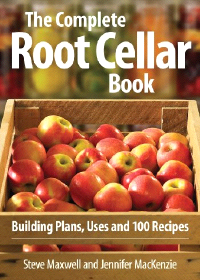Will you risk sounding like you are living in the Little House in the Big Woods if you follow Steve Maxwell and Jennifer MacKenzie‘s The Complete Root Cellar Book (Robert Rose 2010)? Who cares, when root cellars are so interesting and useful.
For the authors, root cellars are not only ecologically important, they are romantic. They are a way of preserving the best of the harvest in the simplest way. This is a complete book about how to build, manage, and fill a root cellar. Root cellars are cool, humid, usually underground places for storing food stuffs like vegetables, fruits, and canned goods so that they will last for months without added outside energy (electricity to run a freezer).
It’s easy to miss the fact that most of us survive, in large measure, on crude oil. Our food may not look, smell, or taste like black gold, but your next supermarket meal probably wouldn’t exist without a lot of diesel fuel and gasoline burned in the background to produce, process, and deliver it. (p. 7)
In response to the Gulf of Mexico oil spill, why not a simple root cellar?
 The first section of the book is about how to build or install a root cellar in a basement or even in a townhouse, condo or standalone. The chapters are complete with do-it-yourself diagrams and essays on spray foam, vents, and the best kind of door. This is a serious manual for those already a little familiar with following how-to books.
The first section of the book is about how to build or install a root cellar in a basement or even in a townhouse, condo or standalone. The chapters are complete with do-it-yourself diagrams and essays on spray foam, vents, and the best kind of door. This is a serious manual for those already a little familiar with following how-to books.
The following section is about storage: how to store – on hooks, in boxes, and in sand; how to choose and prepare food for storage – shocking onions, and salting beans. There is a handy list of foods, that includes information about how long each ingredient will last in a root cellar.
Finally, there follows a whole section of recipes for root cellar foods. Since root cellars are usually used to store root vegetables – beets, potatoes, rutabagas, and the like, these are the ingredients that dominate the recipes. Root Cellar Medley Soup (p. 140) is a thyme flavored soup, or Classic Borcht (p. 144) with beets. Since author Steve is a big beet fan, there are plenty of other beet recipes including Sweet and Tangy Beet and Carrot Salad (p. 151) and Steve’s Balsamic Beets.
You can force Belgian Endive to grow leaves during the winter, so there are recipes for Dilled Cucumber and Belgian Endive Salad (p. 156) to lighten up the root diet. The condiments section is extremely handy even if you don’t plan to build a root cellar. The Preserved Lemons (p. 258) and Pumpkin Orange Chutney (p. 267) are worth making for the long winter.
If you are running a green kitchen, growing fruits and veggies in your garden, and raising chickens, it makes sense to add a root cellar. Maybe it will increase your property value, besides saving the best of your harvest.

2 comments on “The Root Cellar”